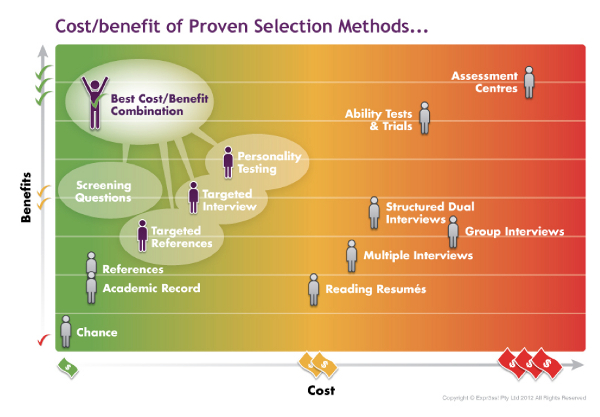Minimising the substantial losses from staff turnover starts with good hiring process and rigour
Everyone knows that staff retention is important, right? That’s why we measure it (you do measure it, don’t you?). But few companies bring that measurement through to the bottom line. Why?… because it’s often regarded as a “soft-cost”, too rubbery for the balance sheet, too uncertain for the CFO.
I find this puzzling, as there is at least as much firm data about calculating the cost of staff churn as there is about executive remuneration… and those figures never seem to be quite so soft!
Many studies have estimated staff turnover costs at between 50% and 200% of annual salary. And most agree that the more senior the position, the higher the percentage.
But what about relatively low-paid hourly employees? Surely these horrendous figures don’t apply to them? Actually, they do… so big or small employer of high or low-paid employees, this is for you!
Cornell University Professors Timothy Hinkin and Bruce Tracey [1] identified the major categories of turnover costs as:
- separation costs,
- temporary replacement and/or overtime costs
- recruitment and associated costs,
- training costs,
- lost productivity (both pre-and post-termination)
When I show this list to managers, executives and business owners, more often than not they nod sagely and then “vague out”. I can almost hear the mental, “Yeah, yeah, yeah” with that fatigued downward cadence that signifies that nothing will change: it’s all too hard.
Somehow it’s not quite real to them. But break this down into a more concrete list and suddenly the cash haemorrhage is evident and the “blood on the floor” appears .
TURNOVER-COST CATEGORIES
Separation Costs
- Exit interviewer
- Employee exit interview
- Paperwork processing
- Severance pay
Recruiting Costs
- Advertising
- Search and agency fees
- Internal referral fees
- Managerial pre-employment admin
- Applicant travel
- Recruiter travel
- Recruiter time
- Misc (correspondence, couriers)
- HR pre-employment admin
Selection Costs
- HR interview
- Managerial interview
- Applicant travel
- Background and reference checks
- Medical exam
- Police Clearance
- HR admin
- Managerial admin
Hiring Costs
- HR administrative functions
- Managerial admin
- Relocation costs
- Signing bonus
- Orientation
- Formal training
- On-the-job training
- Uniforms
- Security
- Informational literature
Lost Productivity Costs
- Vacancy cost
- Pre-departure productivity loss
- Learning curve (lost revenue & customers)
- Errors and waste
- Supervisory disruption
- Peer disruption
- Morale deterioration
Adapted from Hinkin & Tracey [1]
So, let’s work out the blood-loss equation, making a few assumptions:
- you have 100 staff with a turnover of 20%
- industry “best” turnover is 5%
- average annual salary is $50,000 (including on-costs)
- percentage turnover cost of 50% annual salary (lowest of 50% – 200% range)
This means:
- 20 staff leave each year
- 20 people x $50,000 per annum x 50% annual salary
- = $500,000 is lost from the business each year
So a saving to the business of more than $300,000 will be realised as soon as staff retention issues are solved.
And do remember that these fearsome figures wound the business to the same degree regardless of how long the employee has been with you.
Some costs, like recruitment, selection and hiring costs are the same. But lost productivity costs (think lost revenue, lost customers, costly errors and waste, supervisory disruption and deteriorating morale) are very significantly greater when an appointee fails to make the grade early in the job.
So what steps can you take to reduce staff turnover?
Research tells us that the major causes of staff churn are:
- Poor recruitment and selection – “Lack of process and rigour”
- Poor remuneration and reward strategies – “Lack of incentives”
- Poor career development opportunities – “Lack of prospects”
- Poor education and training – “Lack of growth”
- Poor management and supervision practices – “Lack of fairness”
- Poor vision and values – “Lack of meaning”
Organisations can improve any and all of these but by far the greatest leverage point is right at the beginning – getting the right people by getting the recruitment right.
After all, there’s no point in having great retention figures if you’re retaining the wrong people!
Get the right people first
The right people will have the proper combination of the necessary skills (“Can Do”), the requisite personal attributes (“Will Do”) together with the quintessential match to the team and company culture (“Fit To”).
Strangely, the least important of these (the “Can Do”) seems to dominate in most organisations’ hiring decisions. Of course it’s entirely necessary that who you hire should have the necessary minimum skill set, whether that be a driver’s licence or a neurosurgeon’s ticket.
All too often we hire on skills but fire on attitudes… or in other words we hire on the “Can Do”… but fire because of the “Won’t Do”!
Perhaps this is because the only recruitment process most people know involves reading resumes and conducting interviews. That’s a shame because these two activities contribute poorly to recruitment accuracy. A cost-benefit analysis of various recruitment methodologies shows how wasteful this is …
Best predictive accuracy is obtained by combining simple and relatively inexpensive methods in logical order.
- Screen out those applicants who cannot meet minimum skills criteria (“No-Can-Do”)
- Use psychometric screening to prioritise “Will Do” Applicants for telephone interview, highly targeted towards the strengths and weaknesses identified. Follow through with targeted reference checks to build your shortlist.
- Positively avoid reading resumes until the shortlist is completed. This reduces bias from reading what is little more than an “Applicant Advertisement” [2] introduced into what is otherwise a solid, reasonably objective process.
Excellent web platforms with cloud software exist to streamline and automate this process. Improved retention as a result of better recruitment and selection is now eminently achievable. The cost-avoidance achieved as a result makes this a place where employers can cut time, cut costs and cut costly mistakes… staff selection solved!
[1] Timothy R. Hinkin and J. Bruce Tracey Cornell Hotel and Restaurant Administration Quarterly, June 2000; vol. 41, 3: pp.14-21. http://www.cuturnover.com/410600.pdf [accessed 3Dec12]
[2] Brokensha G What is a resume for? http://www.expr3ssion.com/2012/11/whats-a-resume-for/
Acknowledgment: This article was first published in Australian Retailer, February 2013



Totally agree with the above content and the value of a selection tool such as Expr3ss! When looking at cost/benefit it’s often useful to look at your temp workforce. You can save a lot of money by building a pool of reliable temps and avoid labour hire costs and increase productivity.
The other important impact in turnover is the often forgotten cost of requiring your ongoing staff to pick up the slack, this can lead to disengagement. With Expr3ss! you can reduce the time to fill.
Completely agree, there is so much time and money wasted on hiring the wrong people with the “Can do, but Won’t do” attributes.
Using Expr3ss has allowed us to find the “Will do” & “Fit to” applicants quickly and with ease eliminating hours that were previously wasted on reading resumes and face-to-face interviews.
I love how Expr3ss! allows us to secure the best applicants quickly before other employers have got around to reading their resumes.